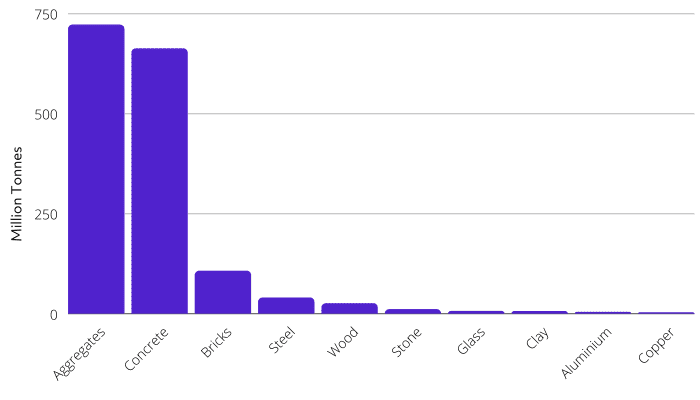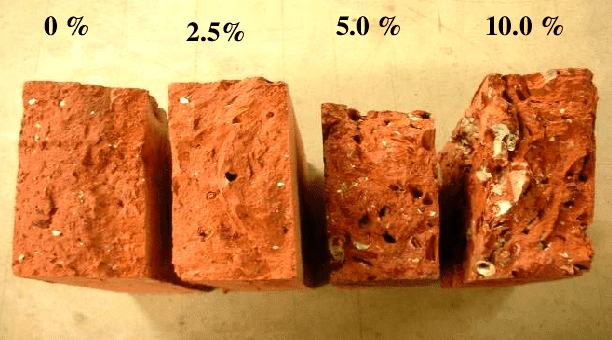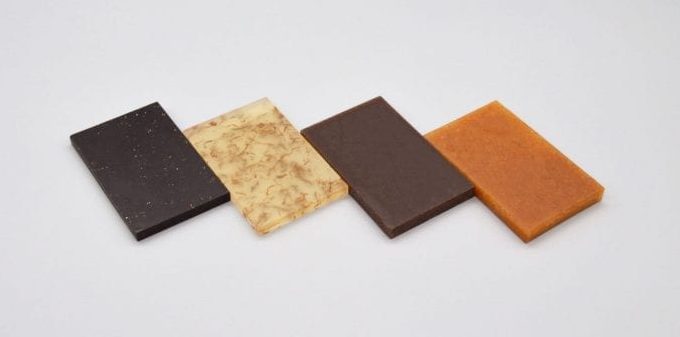Sustainable materials shaping the future of construction
Activists, the scientific community, environmental organisations, and the general public – or clients themselves – continue to call for more sustainable development that addresses a wide variety of factors – from resource efficiency to biodiversity impact.
Using alternative, more sustainable materials in construction projects is often the first stage of moving towards more environmentally responsible builds.
According to the Resource efficiency in the building sector report produced by the Copenhagen Resource Institute for the European Commission, the most commonly used construction materials for buildings (residential, public and commercial but excluding industrial) are aluminium, bricks, clay, concrete, copper, glass, aggregate materials, stone, steel and wood.
Across the member states of the European Union (EU27 as at 2014), here is the breakdown of materials used in construction between 2006 – 2010, in million tonnes.

Source: CRI Calculations as referenced in https://ec.europa.eu/environment/eussd/pdf/Resource%20efficiency%20in%20the%20building%20sector.pdf
According to the same report, annual emissions from production (cradle-to-gate) of the above materials equates to approximately 3 – 4.7% of greenhouse gas emissions of the EU27 in the last decade. Production of concrete alone is responsible for almost a third of all total global warming potential impacts from construction materials, and the impact from steel, aluminium and brick production is also significant.
With that in mind, it’s not difficult to understand why some of the best scientific minds across the world are putting their efforts in the developing new, environmentally friendly, sustainable building materials.
Here are some great examples of the alternative materials being developed and used to help the sector on its way to become more sustainable.
Transparent Wood
Made for the first time in 1992, transparent wood is a composite material with up to 90% transparency. It’s strong and shatterproof, has lower thermal conductivity than glass glazing, and it retains the biodegradable properties of standard woods.
While something first ‘invented’ in 1992 may not seem like an innovative material of the future – and wood-material production obviously comes with its own environmental impact considerations – scientists are still working on scaling up the production of transparent wood for use in large scale construction projects, so it has potential for much wider use than is currently possible.
Source: Youtube
Cigarette butt bricks
Researchers at the Australian RMIT University have found that adding discarded cigarettes to bricks lessens the amount of energy needed for baking, making them cheaper and more eco-friendly to produce.
As well as using 58% less energy during production, these bricks also tackle the issues caused by cigarette butt waste and even make the bricks better insulators. Scientists have also developed technology for incorporating butts into asphalt concrete.
If brick production is still being advanced decades later, what other opportunities might exist?
Cross-sections of bricks containing cigarettes

Source: Possible Utilization of Cigarette Butts in Light – Weight Fired Clay Bricks paper by A. A. Kadir and A. Mohajerani
Potato chipboard
UK start-up Chip[s] Board hit the headlines in 2019 when it announced the development of a new material using waste produce from potato product manufacturer McCain.
Chip[s] Board have developed a sustainable alternative to MDF that combines a binding agent made from potato peel with fibres from waste potato skins, bamboo, beer hops and recycled wood. These ‘Parblex™ Plastics’ are translucent and fully compatible with injection moulding, 3D printing and many other industrial processing techniques.
Although scalability is an issue in rolling out these materials more widely, using a by-product from one industry to create sustainable materials for use in another is inspirational innovation by anyone’s standards.
Parblex™ composite samples

Source: chipsboard.com
Zero-carbon cement
Cement production accounts for around 8% of global co2 emissions so the environmental reward for innovating here is pretty obvious. Thankfully, several companies are already leading the way:
- DB Group has created Cemfree, a zero-cement concrete that can save up to 88% in embodied CO2 without compromising strength
- Cemex launched Vertua, a carbon-neutral product last year
- LafargeHolcim developed a new lined called ECOPact in 2020, a low carbon range that offers 30-100% less carbon emissions compared to CEM1 or OPC concrete
- Concrete Canvas is a concrete-impregnated canvas created by low mass, low carbon technology that uses up to 95% less material than traditional methods
Low or zero-carbon cement is being used in construction projects around the world, so the next aim would be to make this – or similarly sustainable cement alternatives like ferrock or timercrete – the only type of cement in use.
Concrete Canvas being used to make shelters
Source: National Geographic
The construction sector is under great pressure to innovate in response to economic conditions, competition from international markets and changing lifestyles, but the examples above showcase what can be achieved when some of the worlds best minds come together to tackle big issues like sustainability.
If you’ve spent money on developing a new product, process or service over the last 2 – 3 years you may be eligible for tax relief under the governments’ research and development tax relief schemes.
To help you understand the claims process, whether you qualify, and what you might be entitled to, we’ve created this free guide.
Download your guide to R&D in construction

